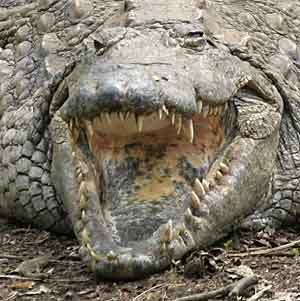Contact Details: Scotch Macaskill, Dirt Road Traders, Currys Post Road, Howick, KwaZulu-Natal, South Africa. Tel: +27 (0)82 578 2329. Privacy: Your privacy is guaranteed. See our Privacy Policy for more. This site accepts advertising and other forms of compensation - see Disclosure and Advertising for details. Site updated: 2022. Copyright © 2002 - 2022 Scotch Macaskill

| ||||||||||
|
||||||||||
|
SEE ALL
|
The Nile Crocodile - Stranger than Fictionby Roddy SmithI have always been impressed by our Australian guests' stories of giant eight metre saltwater crocodiles (Crocodylus porosus). Eventually, however, I realised that not only is the Australian attitude to facts prone to a certain patriotic subjectivity, but almost all of them come from urban backgrounds and have never actually seen a crocodile at all. Australians are not alone in this sort of exaggeration; crocodiles are one of the greatest subjects of myth and exaggeration in the animal world. The biggest reported crocodile ever was a specimen shot in the Bay of Bengal in the 19th century and claimed to be over 10 m (33 ft) long. The skull was preserved in the British Museum, but when examined by modern scientists it turned out to have belonged to a specimen of only 4.8 m (15.74 ft). The biggest reliably recorded crocodile was a "saltie" measuring 6.19 m (20.3 ft) which became entangled in fishing nets, but these are incredibly rare: Tom Cole, an Australian icon who hunted crocs all over the "top end" of Australia and in New Guinea before and after the Second World War, wrote that of over 50,000 skins that he handled only one might have been over 20 ft long. There are fairly reliable records of Nile crocodiles (Crocodylus niloticus) over 5.5 m (18 ft), but these too are very rare. The biggest croc I have measured was 4.64 m (15.2 ft) and it was substantially larger than several specimens I have seen in croc farms which were claimed to be much bigger.
Although I doubt that one would ever become fond of crocodiles they are fascinating animals: the facts are more interesting than the legends. They were already here when the dinosaurs ruled the earth, and they survived when the other great reptiles died out. They are supremely successful predators, able to hunt anything from frogs to buffalos, and they have an amazingly efficient digestive system. Crocodiles have the most acidic stomach known in any vertebrate, which allows them to digest everything they eat including bone, and they have an exceptionally high conversion rate, storing as much as 60% of the energy they consume as fat on the tail and other parts of the body.
They are also able to control their metabolic rate; they can slow their heart down to only two or three beats a minute when they are inactive, and they can widen or narrow their blood vessels to limit or increase blood and oxygen supply to peripheral parts of the body as needed. In addition, being "cold-blooded", they don't use metabolic energy to maintain their body temperature. All this enables them to survive for long periods without eating at all; big crocodiles can go for more than a year without feeding and even new hatchlings can survive for four months on the fat from the remains of the yolk-sac. The penalty for this is that crocodiles lack endurance. They are capable of explosive action, hurtling out of the water to catch animals on the bank or even low-flying birds, but become exhausted if required to sustain effort for more than a short time. Another enduring belief is that crocs store their prey until it is rotten before eating it. This is at best dubious; they are certainly not fussy but when trapping crocodiles we always found they were more likely to take fresh bait than putrid meat. 
The teeth of a Nile crocodile are like pointed pegs Items such as fish are swallowed whole; to reduce bigger prey to manageable portions they clamp it in the immensely powerful jaws and spin their whole bodies to rip chunks off. Cooperative feeding helps them do this; one crocodile may hold a carcass while another grips and spins. Crocodiles congregate in large numbers at carcasses, but feeding is a remarkably orderly process; there is no fighting. Late arrivals wait their turn, and as each one rips a portion off it retires to swallow it and then waits its turn again. They are also known to cooperate in catching fish, forming a line across constricted channels when fish are running through them. Crocodiles have to swallow their food on the surface, even though much of it is seized underwater. This is because they have no lips, and a flap in the throat (which has to be opened to swallow) keeps water out when they are submerged, together with sphincter muscles which close the nostrils. One person I know saved himself, after a croc took him, by forcing the throat flap open: I have the greatest admiration for his presence of mind, but I am going to great lengths to avoid any possibility of trying it myself Roddy Smith is a wildlife conservationist and safari guide based at Mwambashi River Lodge in the Lower Zambezi National Park, Zambia. Images © Scotch Macaskill Return to Wildlife Articles |
|||||||||
|
|
||||||||||
